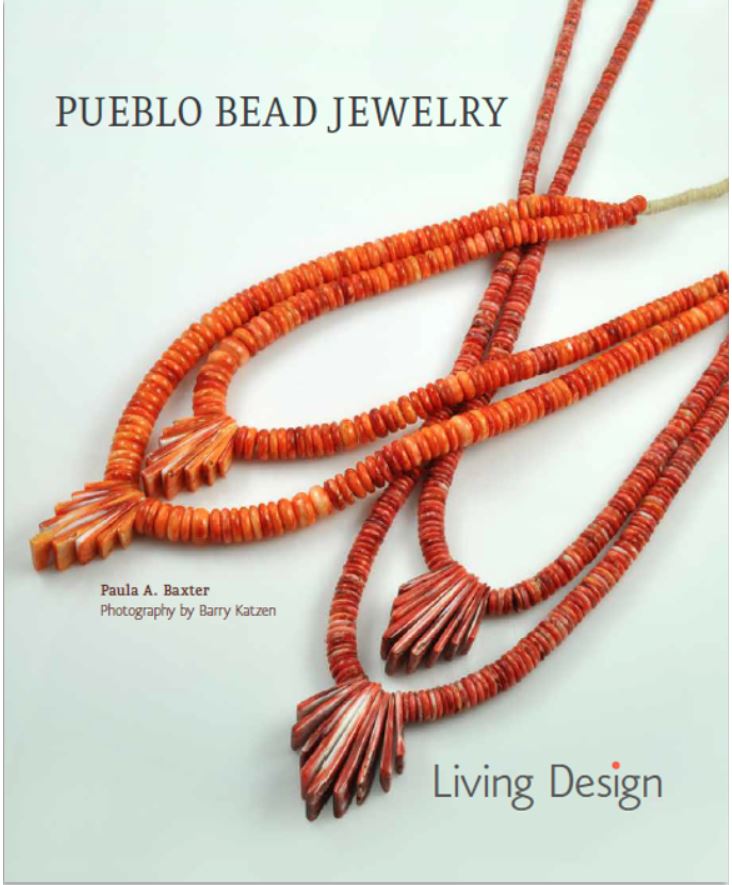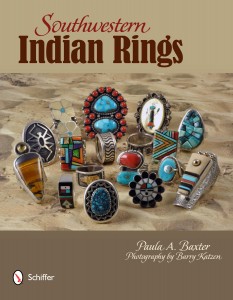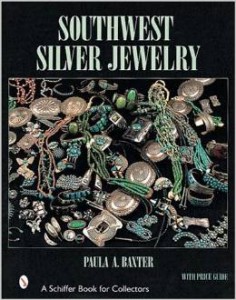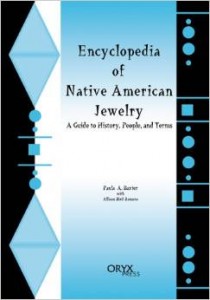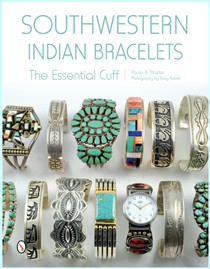Concho belts as we know them — small to huge discs of silver shaped and stamped and made to link together — are becoming fairly rare adornment. Conchos made in the early decades of Southwestern Indian silversmithing are now immensely valuable objects. The best examples appear in museum displays or are hidden in bank vaults. A certain kind of fashionable concho belt shows up on Fashion Week runways and artsy fashion magazine spreads. An even more sketchy type lives in in contemporary western wear.
Indian arts dealers will tell you that these items, originally derived from Spanish and Mexican horse and bridle gear, are hard to sell. Forgeries do abound. Theories about this phenomenon also proliferate. The best concho belts are relatively heavy to wear. What everyone does agree, however, is that when someone models a genuine article that person has made an irrefutable fashion statement!
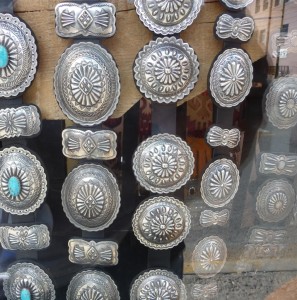 Window display of concho belts, Santa Fe.
Window display of concho belts, Santa Fe.
Located on Camino Lejo, northeast of Santa Fe’s Plaza district, along with the Wheelwright Museum and the Museum of Indian Arts and Cultures, the Museum of International Folk Art has some of the greatest displays and a nifty gift shop. If you think folk art from around the world doesn’t fit in with your itinerary of Native arts searching, reconsider such a notion by visiting this museum. One interesting thing you’ll discover is how many abstract symbols used in art have a broader geographical application than you might suspect. Also, look at how other cultures use turquoise for their adornment, especially in Nepal and Tibet.
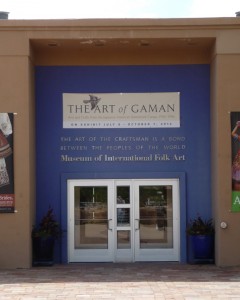 Museum of International Folk Art, Santa Fe, NM
Museum of International Folk Art, Santa Fe, NM
This Santa Fe institution is preparing for an expansion of its galleries in the next few years. I’ve learned that much of this new space will be devoted to showing Indian jewelry from the permanent collection. This offers those of us who love this art form some new educational opportunities. The Wheelwright has always been blessed with its Case Trading Post, one of the best venues for buying Native arts in Santa Fe. There have been new developments in recent years related to jewelry curio sources (this particular one aided by the museum’s director), hallmarks, production history, and scope of work. These new galleries may become a place with important teaching points.
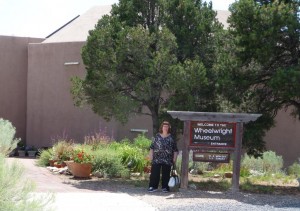 Standing outside the Wheelwright Museum, Santa FE, NM
Standing outside the Wheelwright Museum, Santa FE, NM
The city’s Central Avenue is its Main Street—and it’s also the original Route 66. When moving out to New Mexico in 1962, my parents and I arrived on Central Avenue after coming west from the start of Route 66. We’d just driven in to the city in our big Oldsmobile, when we were suddenly rear-ended! The lady behind us had been staring into a hat (!) shop and forgot to brake in time. The car was so big and sturdy in its metallic body that I wasn’t hurt at all, just thrown onto the floor of the wide back seat.
The Route 66 craze brought a lot of tourists to the state and Central Avenue catered to their needs with restaurants, gift shops, and a slew of adobe motels with swimming pools. I remember those years hazily, but do recall that fast cars, food, and music were entering into our popular culture. I even remember several drive-ins, watching World War II and science fiction movies from the backseat while the dark outline of the Sandias hovered in the background.
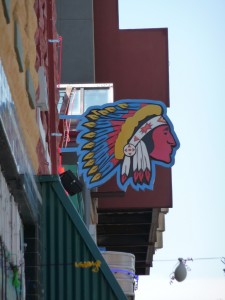 Downtown Albuquerque, on Central Avenue.
Downtown Albuquerque, on Central Avenue.
Great independent bookstores have a pulse all their own. Collected Works in downtown Santa Fe stocks works which spell out the various charms of the Southwest. Their sections on local history, area maps, and Native cultures surpass even the museum bookshops. Yet other areas, such as cookery and small business are also on target. One gets a sense of the cultural diversity of the region, but not at the expense of other critical subjects. Collected Works blooms during events like the SWAIA Indian Market, where they gather new and experienced authors for reading and signings. Santa Fe shopping has changed over the years, but one of the greatest finds for the Indian Country visitor could be that short-run guide to the Turquoise Trail or a novel about a struggling Native weaver who learns from Hispanic artists in the Chama area.
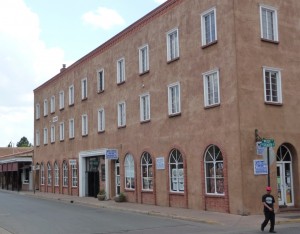 Collected Works Bookstore and Coffeehouse, in Santa Fe.
Collected Works Bookstore and Coffeehouse, in Santa Fe.
One of the most fascinating manifestations of contemporary Native art comes from young Indian artists who use manga, graphic displacement, and humor to showcase their street cred. Young—and older—Natives enjoy paralleling the urban disaffection of gangstas and hip-hop heroes. Their works show a wary distrust of non-Native sympathy for Indian “themes.” One young artist who lives in the Phoenix metro area laughs about how puzzled viewers want to know where the horses are in his work. The American Southwest has cities which have grown large urban areas around their centers. In the exhibit Low Rez, which ran in Santa Fe during summer 2012, humor poked fun at stereotypes and misconceptions about contemporary Indian urban life.
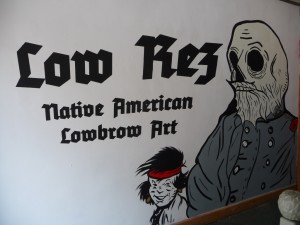 The Low Rez exhibit, Santa Fe, August 2012
The Low Rez exhibit, Santa Fe, August 2012
One of the most popular images, including for design, in Native art is that of the Apache Gan, or Mountain Spirit dancer. This whirling figure, with black face covering and towering headdress, is somehow enchanting and even endearing. Despite the awesome figure he makes, one senses the importance of his actions: to cure and protect. Apaches occupy an interesting space in the imaginations of tourists to the Southwest. There are reservations for different bands in Arizona and New Mexico; some areas have developed tourist attractions, while others haven’t. The outlaw nature of Cochise and Geronimo lives on in popular culture memory. When I talk to people who aren’t particularly knowledgeable about Native Americans, a mention of the Apaches usually evokes affection and respect. Intriguing, huh?
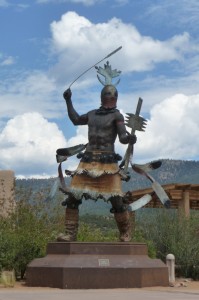 Apache Mountain Spirit Dancer statue (by Craig Dan Goseyun), Museum Hill, Santa Fe, NM
Apache Mountain Spirit Dancer statue (by Craig Dan Goseyun), Museum Hill, Santa Fe, NM
It happened about a year ago to us. It’s one of the inevitable reactions for the tourist in Indian Country, although it doesn’t occur that frequently. We’d risen early to get on I-40 and head eastbound, windshield visor up to deflect the rising sun. It was only about 7 or 7:30 a.m. when we pulled into the McDonald’s off one of the exits in Holbrooke. We ran to the bathroom at once before buying anything. An Indian woman employee was sweeping the still damp floor and the sight of me seemingly disgusted her. She glared at me as I bypassed the “wet floor” stanchion. When I emerged to wash my hands, she observed me pointedly, muttering under her breath.
This past month we revisited the same restaurant at a slighter later hour. No one was cleaning the restrooms and the staff at the counter possessed a weary good nature. Why even write about this? Because such encounters can pierce the bubble we tourists often travel in: that everyone is glad to cheer us on our way. Most Natives I talk to in Indian Country are happy to have work when they get it, but on-the-job discontent knows no ethnic boundaries…
Page One lives on at its location on Montgomery Blvd. I remember the glory days when it had a sister Page Two shop, but most bookstores these days have become diminished operations. Even UNM’s large store off Central Avenue is not what it once was. Page One, however, provides new and used books, some collectibles, nice paper goods, and a welcoming sense of community. Furthermore, visitors to the region will find that its Local History and Native American book sections have wonderful titles for sale, including some remarkable out of print finds. While it’s located in a sleepy strip mall, don’t underrate this marvelous resource.
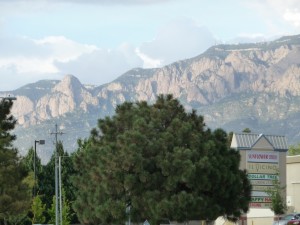 The stock inside Page one is impressive, and the view of the Sandias from the parking lot is pretty nice too.
The stock inside Page one is impressive, and the view of the Sandias from the parking lot is pretty nice too.
The remnants of the Route 66 tourist trade abound along I-40. Some of these remain kitchy and have an old-fashioned air. Others, like the streamlined Route 66 Diner, provide a chance to enjoy the past by embracing its comfort food. It’s interesting to look back and realize that the decades when Route 66 came to life in story and song where the 1950s and 1960s. These years were when the Indian reservations finally got electrification and state-funded high grade tarmac roads for the first time. The television, too, brought a window onto the greater world at large. I lived in Albuquerque briefly in the early 1960s. I visited Acoma and Santo Domingo and was struck by the matter-of-fact ease with which, to my childish eyes, Indians seemingly lived in two worlds at once. Growing up, I realize that analogy was too simplistic. Indians live in the world as any other ethnic peoples do, and their ability to enjoy urban pleasures is equal to anyone’s. Isn’t it time that non-Natives stop referring to Indians as living in two worlds? It’s one world—and still as imperfect as ever.
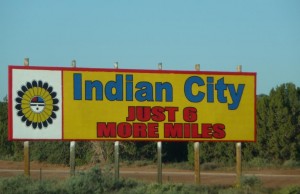 One of the many Indian curio spots on I-40 — a reminder of old Route 66.
One of the many Indian curio spots on I-40 — a reminder of old Route 66.
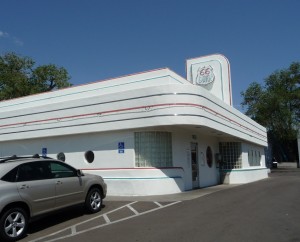 The Route 66 Diner in Albuquerque.
The Route 66 Diner in Albuquerque.
